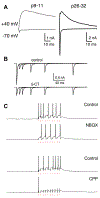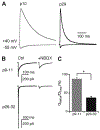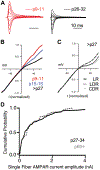An evolving view of retinogeniculate transmission
- PMID: 28965513
- PMCID: PMC6180333
- DOI: 10.1017/S0952523817000104
An evolving view of retinogeniculate transmission
Abstract
The thalamocortical (TC) relay neuron of the dorsoLateral Geniculate Nucleus (dLGN) has borne its imprecise label for many decades in spite of strong evidence that its role in visual processing transcends the implied simplicity of the term "relay". The retinogeniculate synapse is the site of communication between a retinal ganglion cell and a TC neuron of the dLGN. Activation of retinal fibers in the optic tract causes reliable, rapid, and robust postsynaptic potentials that drive postsynaptics spikes in a TC neuron. Cortical and subcortical modulatory systems have been known for decades to regulate retinogeniculate transmission. The dynamic properties that the retinogeniculate synapse itself exhibits during and after developmental refinement further enrich the role of the dLGN in the transmission of the retinal signal. Here we consider the structural and functional substrates for retinogeniculate synaptic transmission and plasticity, and reflect on how the complexity of the retinogeniculate synapse imparts a novel dynamic and influential capacity to subcortical processing of visual information.
Keywords: Developmental refinement; Retinogeniculate synapse; Short-term plasticity; Synaptic transmission; Visual circuit.
Figures




Similar articles
-
Frequency-dependent modulation of retinogeniculate transmission by serotonin.J Neurosci. 2004 Dec 1;24(48):10950-62. doi: 10.1523/JNEUROSCI.3749-04.2004. J Neurosci. 2004. PMID: 15574745 Free PMC article.
-
Functional Convergence at the Retinogeniculate Synapse.Neuron. 2017 Oct 11;96(2):330-338.e5. doi: 10.1016/j.neuron.2017.09.037. Neuron. 2017. PMID: 29024658 Free PMC article.
-
Changes in input strength and number are driven by distinct mechanisms at the retinogeniculate synapse.J Neurophysiol. 2014 Aug 15;112(4):942-50. doi: 10.1152/jn.00175.2014. Epub 2014 May 21. J Neurophysiol. 2014. PMID: 24848465 Free PMC article.
-
Organization, Function, and Development of the Mouse Retinogeniculate Synapse.Annu Rev Vis Sci. 2020 Sep 15;6:261-285. doi: 10.1146/annurev-vision-121219-081753. Annu Rev Vis Sci. 2020. PMID: 32936733 Review.
-
Organization of the dorsal lateral geniculate nucleus in the mouse.Vis Neurosci. 2017 Jan;34:E008. doi: 10.1017/S0952523817000062. Vis Neurosci. 2017. PMID: 28965501 Free PMC article. Review.
Cited by
-
Structural and Functional Plasticity in the Dorsolateral Geniculate Nucleus of Mice following Bilateral Enucleation.Neuroscience. 2022 Apr 15;488:44-59. doi: 10.1016/j.neuroscience.2022.01.029. Epub 2022 Feb 4. Neuroscience. 2022. PMID: 35131394 Free PMC article.
-
Input-specific synaptic depression shapes temporal integration in mouse visual cortex.bioRxiv [Preprint]. 2023 Feb 1:2023.01.30.526211. doi: 10.1101/2023.01.30.526211. bioRxiv. 2023. Update in: Neuron. 2023 Oct 18;111(20):3255-3269.e6. doi: 10.1016/j.neuron.2023.07.003. PMID: 36778279 Free PMC article. Updated. Preprint.
-
Differential Distribution of Ca2+ Channel Subtypes at Retinofugal Synapses.eNeuro. 2020 Nov 5;7(6):ENEURO.0293-20.2020. doi: 10.1523/ENEURO.0293-20.2020. Print 2020 Nov/Dec. eNeuro. 2020. PMID: 33097488 Free PMC article.
-
Development of astrocyte morphology and function in mouse visual thalamus.J Comp Neurol. 2022 May;530(7):945-962. doi: 10.1002/cne.25261. Epub 2021 Oct 25. J Comp Neurol. 2022. PMID: 34636034 Free PMC article.
-
A Fine-Scale Functional Logic to Convergence from Retina to Thalamus.Cell. 2018 May 31;173(6):1343-1355.e24. doi: 10.1016/j.cell.2018.04.041. Epub 2018 May 31. Cell. 2018. PMID: 29856953 Free PMC article.
References
-
- Aguila J, Cudeiro FJ & Rivadulla C (2017). Suppression of V1 feedback produces a shift in the topographic representation of receptive fields of LGN cells by unmasking latent retinal drives. Cerebral Cortex 27, 3331–3345. - PubMed
-
- Akerman CJ, Smyth D & Thompson ID (2002). Visual experience before eye-opening and the development of the retinogeniculate pathway. Neuron 36, 869–879. - PubMed
-
- Albrecht D, Davidowa H & Gabriel H (1990). Conditioning-related changes of unit activity in the dorsal lateral geniculate nucleus of urethane-anaesthetized rats. Brain Research Bulletin 25, 55–63. - PubMed
Publication types
MeSH terms
Grants and funding
LinkOut - more resources
Full Text Sources
Other Literature Sources

